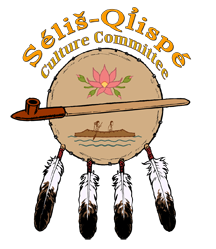
At the heart of The Salish People and the Lewis and Clark Expedition are the elders’ oral histories, recorded in Salish and presented in the book in a bilingual, Salish-English format. Now, as you read the text, you can also listen to the elders’ voices from the Salish-Pend d'Oreille Culture Committee’s original recordings.
Book Details:
The Salish People and the Lewis and Clark Expedition by the Salish-Pend d'Oreille Culture Committee and Elders Advisory Council, University of Nebraska Press (2003 and 2008)
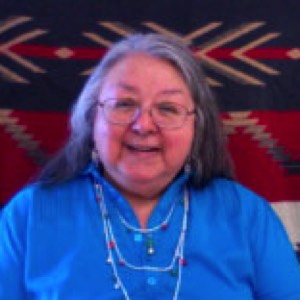
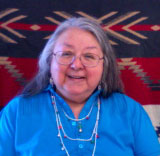 Shirley TrahanEsq̓ey̓ ye q̓ey̓min
Shirley TrahanEsq̓ey̓ ye q̓ey̓min
x̣͏ʷl̓ qe es puteʔm qe x̣͏ʷl̓čmusšn
u yetɫx̣͏ʷa sqlqélix͏ʷ
u y̓e putiʔ c̓n̓en̓n̓es.This book is written
because we respect our ancestors
and the people here today
and the generations yet to come.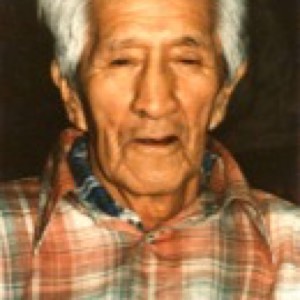
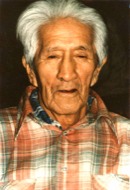 Mitch SmallsalmonⱢu tsq̓si…
Mitch SmallsalmonⱢu tsq̓si…
neɫi l es milk̓͏ʷ ye st̓úlix͏ʷ
u es t̓uk̓͏ʷ ɫu maliyémistis ɫu sqélix͏ʷ…
X̣est! X̣est es ay̓ew̓ti,
x̣est es p̓ox̣͏ʷtil̓ši ɫu
sx͏ʷsix͏ʷlts ɫu tsq̓si sqélix͏ʷ.
I x͏ʷuk̓͏ʷ ye st̓ulix͏ʷ,
i x͏ʷuk̓͏ʷ ye air, ye nwíst,
esyaʔ u x̣e.A long time ago.…
all over this land
the people's medicine was put here…
It was good! Their home life was good,
they were growing up in a good way,
the children of the long-ago people.
The land was clean,
the air was clean,
everything was good.- Pages 12 - 14 — Pete Beaverhead[+]showshow
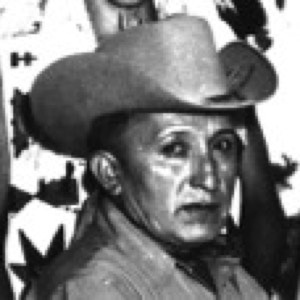
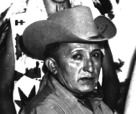 Pete BeaverheadK͏ʷem̓t ɫiʔé iʔs meyeʔm, kʷem̓t ɫu k̓͏ʷɫpaʔx̣nten,
Pete BeaverheadK͏ʷem̓t ɫiʔé iʔs meyeʔm, kʷem̓t ɫu k̓͏ʷɫpaʔx̣nten,
čn nté č̓ tl̓ čeɫl nq̓͏ʷoqey smx̣͏ʷop
u č̓ msɫnq̓͏ʷoqey
cič̓ciʔ.
U npƛ̓mú ec̓x̣ey
ɫu i tmi.
Ɫu iqs cmeyyeʔ ɫu in qnqeneʔ,
i slsileʔ,
i sx̣px̣épiyeʔ,
in lilaw̓iyeʔs,
t̓pt̓úpiyeʔs ɫu es nmicinms….
_________________________
K͏ʷem̓t tl̓ šeʔ cx͏ʷuy,
ye cčč̓ʔe,
u wíʔičis ɫu suyapi.
Nqʷon̓míʔis ɫu suyapi,
i pqpiq,
u es upupus.
Ec̓x̣lús teʔs čɫix͏ʷx͏ʷmu
x̣ʷl̓ is piq i k͏ʷils.
K͏ʷem̓t ɫu číʔicntm ɫu t suyapi
k̓ʷ ƛ̓e cnt̓ešlš ɫu suyapi,
k͏ʷem̓t x͏ʷpx͏ʷéʔepis ɫu ep spum ɫu sic̓m,
še k̓͏ʷɫsux͏ʷmeʔis l šey̓
u qs ɫaqqí.
Cuti ɫu ilmíx͏ʷm,
“N̓em x͏ʷpx͏ʷépntp ci sic̓m, ci ep spum
m l šey̓ m ɫaʔ́aqq.
X̣͏ʷa es siy̓úʔuy̓ti.”
Es nte es siy̓úʔuy̓ti,
u i pqpiqs.
______________________
Tl̓ šeʔ es ctax̣͏ʷllu cx͏ʷuy u miyip
epɫ nčc̓x̣͏ʷc̓x̣͏ʷéʔepletn ɫu suyapi.
K̓͏ʷ ɫu qs cníʔek͏̓͏ʷ
ɫu ʔes šʔit qs cníʔek̓͏ʷmi ɫu suyapi
u ƛ̓e qe tumistmɫls
ɫu qe st̓úlix͏ʷ ɫu l amotqn.
Cuys,
“Qʷu aqs x͏ʷic̓štm t ƛ̓iyéʔ
čiqs ƛ̓emí t st̓úlix͏ʷ.
Epɫ st̓ulix͏ʷ. N̓e ɫu čn wičm t st̓ulix͏ʷ."
K͏ʷemt cuys ɫu amotqis, ɫu king,
“N̓em aq st̓úlix͏ʷ."
K͏ʷem̓t ɫi ɫu, i c̓y̓ú qe es wičɫlt ɫu qe
st̓úlix͏ʷ u ƛ̓e qe tumistmɫlt.
_________________________
K͏ʷem̓t cnt̓éʔešls
U nšt̓úʔulex͏ʷm t scčacé.
U k͏ʷem̓t hoy c̓x̣ey ƛ̓e ƛ̓x͏ʷupmntm.
_________________________
Ɫu es šʔí sqélix͏ʷ wíʔičis,
k͏ʷem̓t k̓͏ʷnk̓͏ʷéʔen̓štm t sq̓l̓q̓l̓é
t scɫk̓͏ʷɫik̓͏ʷ.
Šey̓ ɫu nx̣éʔseʔelsmis, léʔemtmis,
ɫu t sqélix͏ʷ.
K͏ʷem̓t č̓ šey̓ u qe nunnx͏ʷeneʔ.
_________________________
K͏ʷem̓t es mi-i-i-ilk͏ʷ yetɫx̣͏ʷa ye st̓úlix͏ʷ, qe
st̓úlix͏ʷ, ye es čsunk͏͏ʷ —
u c̓x̣ey̓ t lč̓ntéʔes x̣͏ʷl̓ qe nplé.
Qe qx͏ʷqeyx͏ʷɫlt ɫu pn tl̓ qe snlclciʔtn.
U qe cuɫlt ɫu t suyapi,
“Ihéʔ ɫu aqs sqlix͏ʷúlex͏ʷ.
Aqɫ nlciʔtn.”
U qe eɫ ɫsx͏ʷsux͏ʷmešls
tes hehen̓mɫʔu acre,
t qeq st̓úlix͏ʷ, t qeqɫ čmštín.
Qe cuɫlš, “Ihéʔ ɫu aqɫ čmštín,
aqɫ st̓úlix͏ʷ.”
K͏ʷem̓t nx͏ʷʔit, č̓e k͏ʷtnúlex͏ʷ
ɫu smʔawʔúlex͏ʷ
u eɫ k̓͏ʷúʔul̓is
ɫu t suyapi
u qe tumistmɫls x͏ʷic̓šmis nʔeyʔeysis ɫu t
suyapi u cnpilš
u qe p̓in̓mɫlt.
K̓͏ʷ unex͏ʷ či qeqs šimi ci eighty acres,
qeqs snlciʔtn.
Hoy čtax͏ʷlle nʔeyʔeysis ɫu t suyapi,
ɫu st̓lt̓úlix͏ʷ— qe tumi-i-istmntm
u put u qes miš…So this, that I am telling, when I
thought about it,
I think it is from three hundred snows ago
to four hundred snows ago, and even
beyond that time.
And it's the end, like of what is known.
What I am going to tell is what was
passed on to me by my paternal
grandmothers, my maternal grandfathers,
and my paternal grandfathers, by their
great-great-grandparents,
their great-grandparents...
_________________________
Then from there, time passed until it was
closer to our time now,
and the Indians saw the whiteman.
They felt pity for the white people,
because they were white,
and they had beards.
The white men looked as if they were
cold because their faces were white and
red. Then, when the Indian people were
met by the whitemen (because they had
already landed), the Indian people then
spread out their fur blankets and
motioned to the white men to sit on the
blankets. Their chief told them, “Spread
out the fur blankets
so that the white men can sit on them.
Maybe they are cold.” The Indians
thought the white men were cold because
they were white-faced.
_________________________
From that time on, it became known
that the white people had laws.
Right then, when the white men were to
come across the ocean for the first time,
they had already taken ownership of our
land for their king or leader. The
whiteman told their leader,
“You give me a ship to go across to look
for some land.
There is land. I will see land."
He told his leader, his king,
“It will be your land.”
They hadn’t even seen our land yet, and
they had already taken ownership of it.
_________________________
The whiteman crossed and landed, and he
stuck a flag and pole in the ground. And
then it's like they already won our land.
_________________________
The first Indians they saw,
the whites showed them necklaces,
that had been strung.
The people liked them and were glad to
get them. Then from that
we believed and trusted them.
_________________________
Today, this land a-a-a-all over,
our land, this island —
had been tied it up for us.
They chased us from our homes.
And the whiteman told us,
“This is to be your land.
It is where you will live.”
Then they set it up, surveyed it
in 80 acres, to be our land, for each of us
to possess what was left over.
We were told, “Here, you can have
what's left for your land.”
It was a vast area of land, and there was a
lot left over after they gave us those
pieces, and the white people arranged it
so that we sold the land;
we sold it, and it was bought by the
whiteman, and they came in
and crowded us out.
It is the truth, all we got was that eighty
acres, for our place to live.
That’s when the whiteman began buying
it, all the lands — we so-o-o-old it, and
now it is almost all gone... - Pages 15 — Mitch Smallsalmon[+]showshow
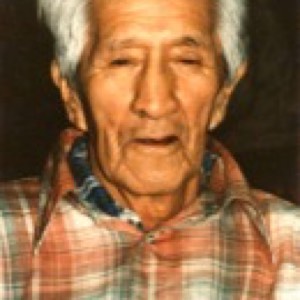
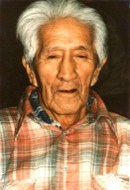 Mitch SmallsalmonK͏ʷem̓t l šey̓ u es čšín, u ɫu x̣͏ʷa l čen̓
Mitch SmallsalmonK͏ʷem̓t l šey̓ u es čšín, u ɫu x̣͏ʷa l čen̓
u ax̣ey u ɫu es šʔí suyá cx͏ʷuy,
ɫu es custm Columbus.
K͏ʷem̓t ɫu cnt̓ešlš, u wičis ye st̓úlix͏ʷ,
t̓ipncú ɫu tl̓ ƛ̓iyéʔs
u nšt̓ulex͏ʷis ɫu scčacé.
C̓x̣ey es lemti,
es lemti tix͏ʷ st̓úlix͏ʷ.
U wičis, we wičis ye sqélix͏ʷ,
tutupiyew̓t,
es tʔacc̓x̣.
K͏ʷem̓t ta es misten,
ta ciqs cu ɫu, ɫu l šey̓
u ec̓x̣ey̓ ɫu sc̓k̓͏ʷɫpaʔax̣s ɫu suyá.
_______________________
K͏ʷem̓t ck̓͏ʷɫčí u ƛ̓e,
ƛ̓e p̓ix̣is ye st̓úlix͏ʷ.
ƛ̓e wičm t qs st̓úlix͏ʷ,
u ta x̣͏ʷa es k͏ʷestc ci,
cniɫc snčc̓x͏ʷeples.
Ɫu c̓x̣ey qs nčmeɫx͏ʷ
ye t qe sqélix͏ʷ,
k̓͏ʷ ɫu t st̓úlix͏ʷ c̓x̣ey ta es čsewpleʔis
čmi neɫi
k͏ʷem̓t č̓ snčc̓x̣͏ʷepletis
u tk̓͏ʷuntes.Then that’s when people said
the first whiteman here came
from what you call Columbus.
When he came across and saw this
land, when he got off his ship,
he put his flag in the ground.
I guess same as saying he was glad,
glad to have and own some land.
He did see the Indians
standing in groups
all staring at him,
but I’m not going to say
what was on their minds —
I mean, about the white people.
________________________
Then, just as soon as he was on the
ground, just like he put a brand on this
land. He found the land,
but I don’t think he carried
any kind of important papers about
laws. And to come here
and take away and claim our Indian
land — he didn’t even have permission
from anyone to take our land,
but I guess they thought they’d just
go ahead and use their own laws. - Pages 20 — Mitch Smallsalmon (read by Shirley Trahan)[+]showshow
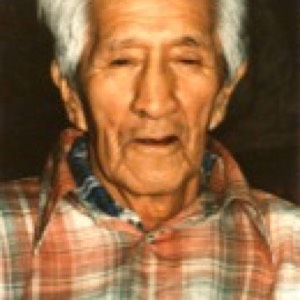
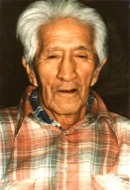 Mitch SmallsalmonNeɫi ɫu tsq̓si
Mitch SmallsalmonNeɫi ɫu tsq̓si
ɫiʔe sqélix͏ʷ
ɫu es x͏ʷlx͏ʷílt
l milk̓͏ʷ u esnpyélsi…
Ta ma l šey̓ u ec̓x̣ey
ɫu sqélix͏ʷ ɫu tsq̓si.
Esyaʔ ɫiʔe x͏ʷix͏ʷey̓uɫ —
x͏ʷʔit ɫu x͏ʷix͏ʷey̓uɫ.
X͏ʷʔit ɫu tʔe stem̓
u ɫiʔe st̓úlix͏ʷ i x̣est
u ɫiʔe sx̣aap i x͏ʷuk̓͏ʷ.Of course, long ago
the Indian people
who were living
were happy all the time…
You know, that’s how Indians
were a long time ago.
All these animals —
there were many animals.
Plenty of everything,
and this land was good.
And the air here was clean. - Pages 23 — Pete Woodcock[+]showshow
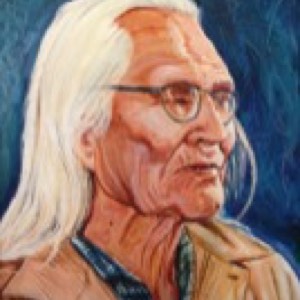
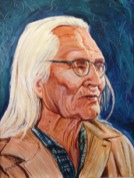 Pete Woodcock
Pete Woodcock
painting by Dwight BilledeauxN̓e tma ɫu tsq̓si
l še u ec̓x̣ey
ɫu sqélix͏ʷ.
Ye sp̓eƛ̓m, ye sx̣͏ʷeʔli,
ye seč
ci esyaʔ —
u es k̓͏ʷl tk̓͏ʷneʔi ɫu sqélix͏ʷ
ɫu x̣͏ʷl̓ n̓e ʔistč.You know, a long time ago,
this is the way it is
with the Indian people.
The bitterroot, the camas,
wild onion,
and everything else —
the Indian people are gathering and storing
for the winter months ahead. - Pages 23 — Pete Beaverhead[+]showshow
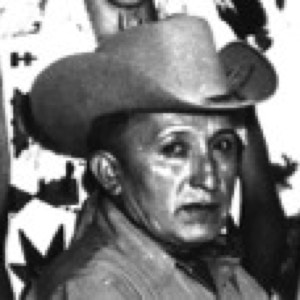
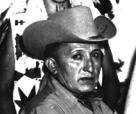 Pete BeaverheadK͏ʷem̓t n̓e ci eɫ nk̓͏ʷu spq̓niʔ
Pete BeaverheadK͏ʷem̓t n̓e ci eɫ nk̓͏ʷu spq̓niʔ
še ƛ̓e es t̓ix͏ʷllm,
tʔe stem̓ ɫu eɫ es k̓͏ʷul̓lm.
Šey̓ ɫu c̓x̣ey tʔes
šlčmncuti ye sp̓iqaɫq,
u ye scx̣ect,
u y̓e sqq̓m̓e,
u y̓e sčɫip.
L milk̓͏ʷ u es q̓͏ʷapmi,
l milk̓͏ʷ u es tix͏ʷm.
Then the following month,
they do something different,
they are working on something.
Things are rotating, going in a circle all the
time, like the berries or things you pick,
the roots and things you dig,
and the fishing,
and the hunting.
They are constantly moving,
gathering things all the time. - Pages 25 — Pete Woodcock[+]showshow
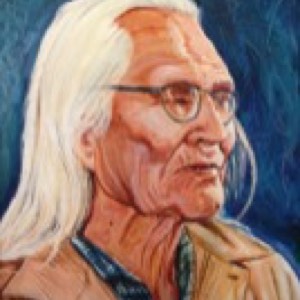
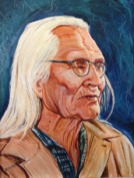 Pete Woodcock
Pete Woodcock
painting by Dwight BilledeauxⱢu t q͏ʷoyʔe c̓x̣ey cwičtn ɫu ilmilk̓͏ʷ
ɫu isnk͏ʷsqélix͏ʷ,
tma ɫiʔe qepc x̣͏ʷa put stem̓ ɫu spq̓niʔ,
še tix͏ʷntm ɫu qs cʔiʔiɫis.
Ɫu tin p̓x̣͏ʷp̓x̣͏ʷot x̣eʔect ɫu t sp̓eƛ̓m…
Wis x̣eʔect ɫu t sp̓eƛ̓m
k͏ʷem̓t čtax̣͏ʷlle x̣eʔect ɫu t,
ɫu t sx̣͏ʷeʔli… seč… qɫ nmeƛ̓mn
ɫu l sq͏ʷoleʔeps.
K͏ʷem̓t tiʔix͏ʷis ɫiʔe qʔes custm
šaw̓tmqn, y̓e Snč̓l̓e q̓͏ʷomqeys.What I have seen when I was growing up
was my fellow Indian people,
during some month in the spring,
starting to gather their food.
My parents would dig bitterroot…
After they were done digging bitterroot
then they would start to dig
camas… onions… to be a mixture
in their camas baking.
Then they would pick what we call
šaw̓tmqn (tree moss), this Coyote’s hair. - Pages 26 — Mose Chouteh[+]showshow
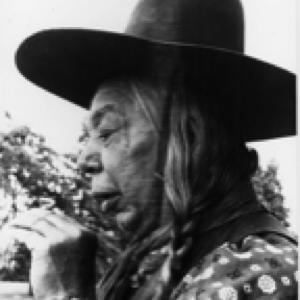
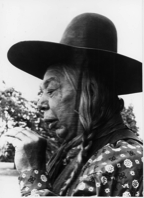 Mose Chouteh
Mose Chouteh
Ɫu tsq̓síp, ɫu es custm swiqɫc̓eʔ
— ɫu l sʔánɫq —
put c̓ʔék̓͏ʷ ɫu x͏ʷy̓é,
še im̓š ɫu qe p̓x̣ʷp̓x̣ʷot
t čɫčewšlš,
es tixʷcní t q̓ʷeyq̓ʷay.
Še put č̓eyʔiʔilš,
še eɫ ct̓kʷk̓͏ʷelp.
Eɫ im̓š —
es custm es ʔem̓šl̓wi.
Put qepc,
še eɫ ct̓kʷk̓͏ʷelp.
Ɫu qe p̓x̣ʷp̓x̣ʷot, ɫu qe x̣ʷlč̓musšn.A long time ago, what is called swiqɫc̓eʔ
— the summer hunt —
just when the wild roses bloom,
our parents and elders
moved to the plains country,
to harvest buffalo.
Towards fall,
they would move back home.
Then they move back again —
this is called es ʔem̓šl̓wi — moving from
camp to camp. When spring came,
they moved back home again.
These were our parents, our ancestors. - Pages 36 — Pete Beaverhead[+]showshow
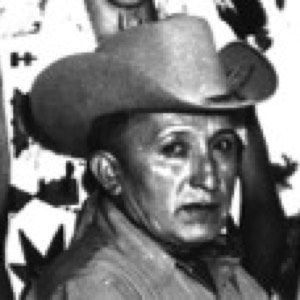
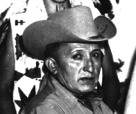 Pete BeaverheadTl̓ šey̓ u x̣eyɫ xʷeʔúlexʷ
Pete BeaverheadTl̓ šey̓ u x̣eyɫ xʷeʔúlexʷ
ɫu uɫ ʔAmtqné,
uɫ Snq̓ʷeymncú,
uɫ Snk̓ʷɫxʷexʷem̓i.
L še u xʷʔit sck̓ʷulsc ɫu Snč̓l̓é.
Kʷem̓t t še u šiy̓ú-u-u-u-u-u
ncčn̓šncu u c̓spnúʔuys
ɫu kʷtkʷtu-u-unt xʷixʷey̓úɫ.
From here there are many places,
like ʔAmtqné,
and Snq̓ʷeymncú,
and Snk̓ʷɫxʷxʷem̓i.
This is where Coyote did many things.
Coyote we-e-e-e-e-ent through there,
going all around and getting rid of
all the hu-u-uge animals.
- Pages 41 - 50 Missoula Valley Area read by Tony Incashola[+]
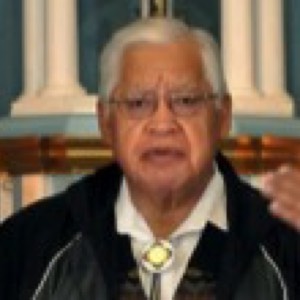
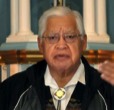
Tony Incashola
Page 41: area at the base of Evaro Hill.
Salish name: Snɫp̓ú(pƛ̓m̓)
Translation: Place Where You Come Out to a Clear Area
Page 44: the Council Grove area.
Salish name: Člmé
Translation: Tree Limb Cut Off
Other Salish name: Ncx̣͏ʷotew̓s
Page 46: the Missoula area / confluence of Rattlesnake Creek & Clark Fork River.
Salish name: Nɫʔay(cčstm)
Translation: Place of the Small Bull Trout.
Page 49: Pattee Canyon and trail to Deer Creek and ford of Clark Fork near Bonner.
Salish name: Sloʔté.
Translation: Two Valleys Coming Together to Make One Little Valley.
. - Pages 51 - 54 Blackfoot River Drainage read by Tony Incashola[+]
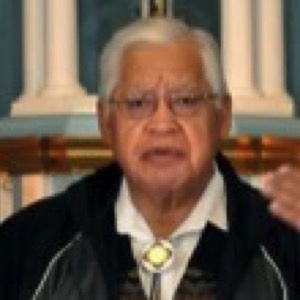
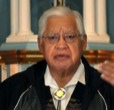
Tony Incashola
Page 51: the Bonner area / confluence of Blackfoot and Clark Fork Rivers.
Salish name: Nʔaycčstm.
Translation: Place of the Big Bull Trout.
Page 52: camas digging grounds near Potomac, Montana.
Salish names: Qal̓sá and Epɫ ítx̣͏ʷeʔ
Translation: Epɫ ítx̣͏ʷeʔ means It Has Camas
Page 54: Lewis and Clark Pass.
Salish names: Smítu Sx̣͏ʷcuʔsí
Translation: Indian Fort Pass
. - Pages 55 - 64 Bitterroot Valley (North Half) read by Tony Incashola[+]
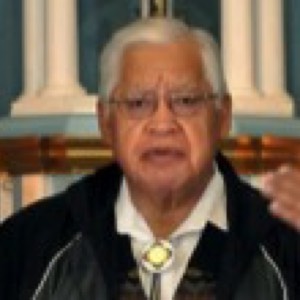
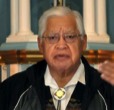
Tony Incashola
Page 55: Lolo area / confluence of Lolo Creek & Bitterroot River.
Salish name: Tmsmɫí
Translation: No Salmon
Page 58: Lolo Trail.
Salish name: Naptnišá
Translation: Trail to the Nez Perce
Page 59: Lolo Hot Springs area.
Salish name: Sntt̓mčqey
Translation: Steam on a Ridge Top
Page 60: Lochsa and Clearwater River system.
Salish name: Ep Smɫí
Translation: It Has Salmon
Page 61: Bitterroot River.
Salish name: Nstetčcx͏ʷetk͏ʷ
Translation: Waters of the Red Osier Dogwood
Page 62: Stevensville area.
Salish name: Ɫq̓éɫml̓š
Translation: Wide Cottonwoods
. - Pages 65 - 78 Bitterroot Valley (South Half) & Big Hole read by Tony Incashola[+]
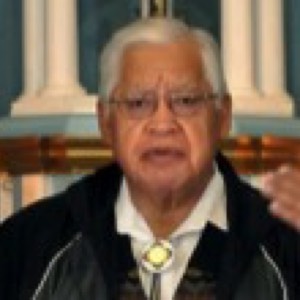
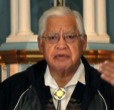
Tony Incashola
Page 65: the Bitterroot Mountains.
Salish name: Čk͏ʷlk͏ʷlqéyn
Translation: Red-Topped Peaks
Page 66: Hamilton area.
Salish name: Čɫc̓lc̓lé
Translations: Scattered Trees Growing on Open Ground or Trees Standing in Water
Page 68: Skalkaho Trail and Pass.
Salish name: Sq̓x̣q̓x̣ó
Translation: Many Trails
Page 69: Sleeping Child Hot Springs.
Salish name: Snetetšé
Translation: Place of the Sleeping Baby
Page 71: Darby area.
Salish name: Snk̓͏ʷɫx͏ʷex͏ʷem̓í
Translation: Place Where They Would Lift Something
Page 72: trail along West Fork of Bitterroot River.
Salish name: Snʔam̓šá
Translation: A Trail Used Frequently for Moving Camp Back and Forth
Page 73: the Medicine Tree.
Salish name: Čq̓ʔé
Translation: Where the Ram's Head Got Stuck
Page 76: Ross's Hole.
Salish name: K͏ʷtíɫ P̓upƛ̓m̓
Translation: Big Open or Big Clear Area
Other Salish name: Sk͏ʷtíɫ X̣súlex͏ʷ
Page 78: Big Hole River.
Salish name: Sk͏ʷumcné Sewɫk͏ʷs
Translation: Waters of the Pocket Gopher
.
- Page 141 — Dolly Linsebigler [+]showshow
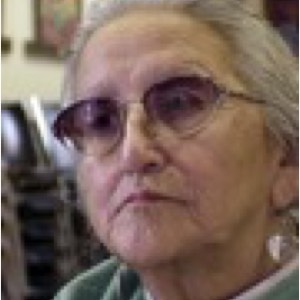
 Dolly LinsebiglerČn nte n̓em x̣e ye q̓ey̓min ɫuqs wiʔičms
Dolly LinsebiglerČn nte n̓em x̣e ye q̓ey̓min ɫuqs wiʔičms
ɫu t, ɫu t qe sx͏ʷsix͏ʷlt ɫu t esyaʔ;
qs mipnuʔunms l čen̓ u ec̓x̣ey es x͏ʷuyi
ɫu suya, suyapi.
U čn nte n̓em x̣e ye q̓ey̓min ɫuqs
wiʔičms ɫu itox̣͏ʷ.
U nex͏ʷ ɫu t qe sx͏ʷsix͏ʷlt
qs mipnuʔunms esyaʔ ɫu sck̓͏ʷul̓s ɫu qe
p̓x̣͏ʷp̓x̣͏ʷot ɫu qe x̣͏ʷlč̓musšn.
U čnte n̓em x̣e ɫu x̣͏ʷl̓ qe sx͏ʷsix͏ʷlt.
Iše čnte x͏ʷʔit k͏ʷmiʔ mimipnuʔuys ɫu t
qe sx͏ʷsix͏ʷlt ɫu qe nk̓͏ʷul̓mn ɫu esyaʔ.
Tl̓ šey̓ m nex͏ʷ mipnuʔuys
ɫu t sx͏ʷsix͏ʷlts n̓e t čen̓ tix͏ʷ sx͏ʷsix͏ʷlt
ɫu itox̣͏ʷ ɫu sx͏ʷsix͏ʷlts
ɫu qe p̓x̣͏ʷp̓x̣͏ʷot qe Séliš.I think it will be good for all of our children
to see this book;
and all of us to learn how the
white people are doing things.
I also think it will be good for them to see
in this book the truth.
And then the children
will learn all of the ways of our
old people, our ancestors.
I hope our children will learn more about
all of our ways.
Then from that, our children’s children,
when they have children, they will learn
the truth about the way the Salish lived,
our old people. - Page 144 - 148 — Pat Pierre[+]showshow
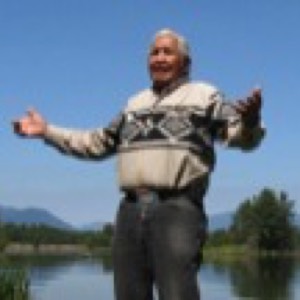
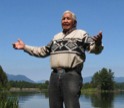 Pat PierreX͏ʷʔit ɫu tsq̓sip ɫu qe nk̓͏ʷul̓mn ɫu qe
Pat PierreX͏ʷʔit ɫu tsq̓sip ɫu qe nk̓͏ʷul̓mn ɫu qe
sqélix͏ʷ c̓x̣ey es nɫpɫetptmm…
x͏ʷu-u-uy u c̓x̣ey, c̓x̣ey x̣͏ʷq̓͏ʷoʔscut ɫu
šey̓. C̓x̣ey č̓e ič̓ tam u q͏ʷo es tax̣͏ʷllus ɫu
qe nk̓͏ʷul̓mn.
________________________
Tam qe esyaʔ u l še u qe ec̓x̣ey. Puti
x̣͏ʷa qe čk̓͏ʷink̓͏ʷnš ɫu puti qe es ččnčn̓im
ɫu, ɫu unex͏ʷ qe nk̓͏ʷul̓mn ɫu qe
sqélix͏ʷ. . . .N̓em tl̓šey̓ m eɫ yoyootwil̓š
ɫu qe nk̓͏ʷul̓mn.
________________________
Ɫu tsq̓sip ɫu qe cčiciɫlt ɫu tl̓ nisq̓͏ʷo
ɫu t suyapi u tl̓ šey̓ u c̓x̣ey ct̓ix͏ʷllm.
Qe cqeyx͏ʷɫlt u ye lʔe.
Ye l qe šnúlex͏ʷ lʔe u qe qe ƛ̣lip.
Č̓e tam k͏ʷtnúlex͏ʷ ye qe st̓úlix͏ʷ.
U ɫu tsq̓sip ɫu putuʔ t še
u cniʔek̓͏ʷ ɫu suyapi, esyaʔ ɫiʔe u qe
st̓úlix͏ʷ, tl̓ čsunk͏ʷ u č̓ čsunk͏ʷ,
tl̓ ƛ̓áq̓lex͏ʷ u č̓ c̓altúlex͏ʷ.
Esyaʔ u sqlix͏ʷúlex͏ʷ.
________________________
K͏ʷem̓t esyaʔ u qe es yoʔstem ɫu qeqs
sck̓͏ʷul̓. Ta qe es q͏ʷn̓mscut ɫu t sʔiɫn.
Ta qe es q͏ʷn̓mnscut t stem̓. Šimi qeqs
čtem̓tn esyaʔ u qe es k͏ʷestm…
________________________
Esyaʔ ɫu qe, ɫu sm̓im̓iʔ iše t suyapi iše
cmimiʔntes es cu t suyapi, es custm
"History." T qʔenple qe es custm
"Sm̓im̓iʔ." Esyaʔ ɫu scq̓eʔey̓s u itam.
X̣͏ʷl̓ šey̓ yetɫx̣͏ʷa qe es k̓͏ʷul̓i,
sk̓͏ʷl̓ɫq̓ey̓mini. Sqélix͏ʷ scuwewlš u es
q̓ey̓q̓ey̓, sqélix͏ʷ sck̓͏ʷɫpaʔx̣s.
________________________
N̓em l še m ax̣ey m mipnuʔuys sic
st̓ulix͏ʷ ye l šimi aʔac̓x̣eys ye q̓ey̓min.
Mipnuʔuys ɫu unex͏ʷ sm̓im̓iʔ ɫu l še u
ec̓x̣ey ɫu tl̓tsq̓sip u yetɫx̣͏ʷa.
N̓em mipnuʔuys k̓͏ʷeʔs yoʔoq͏ʷisti ci
k̓͏ʷiƛ̓t itnm̓us ɫu scq̓eyq̓eʔeys.
Yetɫx̣͏ʷa ye l qe q̓ey̓min
esyaʔ u itox̣͏ʷ ɫu es meyyeʔm.
________________________
U tlciʔ k͏ʷn̓ew pɫiɫt ɫu q̓ey̓min k͏ʷɫu,
k͏ʷɫu qe esyaʔ qe q̓ey̓ntem.
Šey̓ k͏ʷn̓ew ɫu isnk͏ʷɫp̓x̣͏ʷp̓x̣͏ʷot ɫu ƛ̓e
sqlqélix͏ʷ ɫu ƛ̓e čx̣͏ʷect tl̓
clčɫʔupnspentč, tq̓nčɫsʔupnspentč,
sp̓lčɫʔupnspentč, k͏ʷɫu iše meyyeʔm ɫu
putiʔ snɫk͏ʷk̓͏ʷmiʔis ye st̓ulix͏ʷ, k͏ʷn̓ew
q͏ʷamq͏ʷmt ɫu esyaʔ u itox̣͏ʷ ɫu
iscmeyyeʔ ɫu x̣͏ʷl̓ šey̓.
________________________
X̣͏͏ʷl̓ šey̓ u qe es uwewlši t sqelix͏ʷ—
tma yoyoot ɫu qe nuwewlštn.
Yoyoot u ep snʔeys.
Ta qes x͏ʷeʔcin še qe ʔawʔawntm x͏ʷʔit.
Ta qe es x͏ʷeʔcin še ƛ̓e miip ɫu qe
scntels.
________________________
X̣͏ʷl̓ šey̓ u yoyoot ɫu qe nuwewlštn. X̣͏ʷl̓
šey̓ u yetɫx̣͏ʷa qe es mimeyeʔm ɫu qe
sccm̓el̓t qeɫ k͏ʷnnuʔunms ɫu qe
nuwewlštn…
________________________
X̣͏ʷl̓ šey̓ yetɫx̣͏ʷa u iše qe, qe cuti,
"K͏ʷmiʔ l čen̓ u ec̓x̣ey u t esyaʔ qe
snk͏ʷsqélix͏ʷ eɫ cp̓lč̓uʔusm, u eɫ k͏ʷeʔeys
ɫu qe nk̓͏ʷul̓mn. Eɫ c̓nap ɫu l snihew̓sm.
X̣eyɫ k͏ʷn̓ew q͏ʷu eɫ yoyoot. K͏ʷn̓ew
q͏ʷu eɫ yoʔpy̓ewt. Ta t stem̓ qeqs
mʔečtmɫlt k͏ʷɫu qe eɫ k͏ʷnnuntm esyaʔ
ɫu qe nk̓͏ʷul̓mn."
________________________
Še ye iʔs meyyeʔm yetɫx̣͏ʷa ye ye
sm̓im̓iʔ, tsn̓e cn cu "History," itam.
̓e, ƛ̓e čn cʔac̓ɫq̓ey̓mi
u ac̓ʔac̓x̣n ɫu scq̓ey̓s ɫu suyapi, itam,
itam une. X̣͏ʷa snspu,
x̣͏ʷa sck̓͏ʷɫpaʔx̣, x̣͏ʷa stem̓ ɫu
q̓ey̓nteʔes…
________________________
Ɫu t qʔenple ɫu qe sqelix͏ʷ, ɫu qe
ʔuwewlš ɫu qe m̓im̓iʔim̓ ɫu putiʔ qe es
mistem ɫu tsq̓sip qe m̓iʔm̓ʔintem, šey̓
ɫu itox̣͏ʷ. Šey̓ ɫu n̓em, n̓em ɫu n̓e čna es
sunum̓t čna ac̓x̣eys ye q̓ey̓min n̓em cu,
"Šey̓ ɫu une." X̣͏ʷl̓ šey̓ u yetɫx̣͏ʷa qe
q̓͏ʷeyɫmiʔ qe es k̓͏ʷɫ q̓ey̓mini. Sqelix͏ʷ
sm̓im̓iʔs, sqelix͏ʷ scmeyyeʔs, šey̓ ɫu
qeqs tk̓͏ʷum. Šey̓ ɫu qes šʔiti. N̓eqs
mipnuʔunms ye, ye t k̓͏ʷiƛ̓t; ye t suyapi,
ɫu t k̓͏ʷiƛ̓t qs mipnuʔunms. "ʔa, k̓͏ʷ ɫ še u
ec̓x̣ey. K̓͏ʷ šey̓."
________________________
Es oym ɫu sqelix͏ʷ ɫu tsq̓sip. C̓x̣ey es
k͏ʷupm, es k͏ʷplwism.
K͏ʷem̓t q̓eyiʔim t sm̓im̓iʔ še č̓ tam u es
tax̓͏ʷllus. Yetɫx̣͏ʷa qeɫ tx̣͏ʷmip. K͏ʷmiʔ,
k͏ʷmiʔ eɫ tx̣͏ʷox̣͏ʷ, tx̣͏ʷmil̓š esyaʔ ɫu qe
scmeyyeʔ n̓e qes miiʔims,
n̓e qs mipnuʔunms k̓͏ʷi
tam ci ci suyapi scq̓ey̓s.
Č̓ tam u es tax̣͏ʷllus.
Ɫu sqélix͏ʷ es mistes putiʔ.
________________________
Ɫu t q͏ʷoyʔe ɫu čn cp̓x̣͏ʷtil̓š u čn̓es
sunum̓t es m̓im̓ištw̓e. Es meyyeʔstm ɫu
šey̓ x͏ʷic̓ɫtn ɫu l isx͏ʷsix͏ʷlt. Esyaʔ ɫu l
islsileʔ, isx̣px̣epeʔ,
t̓pt̓upiyeʔ. Esyaʔ n̓em x̣͏ʷiʔic̓ɫtn qs
yoʔnuʔunms esyaʔ ɫu qe nk̓͏ʷul̓mn ɫu
maliyemistn…
________________________
Qe es tx̣͏ʷmim ɫu qe sm̓im̓iʔ ɫu sqelix͏ʷ
sm̓im̓iʔs ɫu tl̓ tsq̓sip u yetɫx̣͏ʷa. K͏ʷmiʔ,
k͏ʷmiʔ esyaʔ ɫu uɫ p̓x̣͏ʷp̓x̣͏ʷot sqélix͏ʷ
k͏ʷmiʔ esyaʔ u ep sm̓im̓iʔ meyyeʔs ɫu l
še u ec̓x̣ey ɫu unex͏ʷ l še u ec̓x̣ey.
Yetɫx̣͏ʷa qe es q̓͏ʷeyɫmiʔsti ye x̣͏ʷl̓
q̓eymin n̓e qs mipnuʔunms ɫu i tox̣͏ʷ;
putu lše u ec̓x̣ey. Tam ɫu suyapi
sm̓im̓iʔs…
________________________
Še yetɫx̣͏ʷa lemlmtš u čn̓ep scuwewlš.
K͏ʷmiʔ, k͏ʷmiʔ sunum̓t ɫu isnk͏ʷsqelix͏ʷ
ɫu iscʔuwewlš.
Ɫu qe es lq̓laq̓isti iše čn č̓uč̓awm ɫu n̓e
x̣est ɫu i šušw̓eɫ, n̓e x̣est nx̣saqs,
isclq̓laq̓ist, iscč̓uč̓aw, in nk͏ʷul̓mn, n̓em
x͏ʷu-u-uy put čen̓ m čn̓eɫ k̓͏ʷɫʔac̓x̣mist m
wičn — hayo! Cɫp̓im ɫu isnk͏ʷsqélix͏ʷ,
es ƛ̓eʔems ɫu x̣est nx̣stin ye l st̓úlix͏ʷ.
Nyoʔpy̓ew̓tn qs x̣ésti.
Šey̓, šey̓ ɫu iscč̓uč̓aw.
________________________
K͏ʷmiʔ l še u ec̓x̣ey.
K͏ʷmiʔ esyaʔ ɫu isnk͏ʷsqélix͏ʷ u
cp̓lč̓uʔusm u eɫ qllx͏ʷwiʔil̓š.
Many of the ways of our people of long
ago, it is like they are being forgotten. . . .
Those ways have, like, like separated
from us as time went on. It is like our
ways is going the wrong way.
________________________
Not all of us are like that. There are still
some of us who still hold on to the real
ways of the people. . . . That is how our
culture will become strong again.
________________________
A long time ago, when we were met by
the white people, from there on, our
culture changed. We were chased until
we came here. Here, in this area, is where
we stopped. Our land is no longer big. A
long time ago, when the white people
came across the water, all of this land
was ours, from island to island, from the
south to the north.
It was all Indian land.
________________________
Then, we knew how to do all of our own
ways. We were not without food. We did
not go without anything. Whatever we
needed, we had it all…
________________________
All of our stories were told; when the
white people came they called it
“History”; we call it “Sm̓im̓iʔ” (our news).
Everything they wrote is not right.
That is why now we are working, making
a book. The words of the Indian people are
written in it; the Indian people’s thoughts.
________________________
This is how the people will learn about
our land, by reading this book.
They will learn the real history from a
long time ago to the present.
The people will learn that the books that
were written by others were lies; what
they wrote was not the truth. Now, in
our book, everything that is taught is
straight.
________________________
The book would be even thicker if
everything was written in it.
Then if my fellow elders
older than fifty years old,
sixty years old,
seventy years old, if they
would tell what they remember about the
land, it would all be really nice, and it
would be the true stories about that.
________________________
That is why we are teaching our
language—because our language has
strength. It is strong and it has value. We
do not say many words, but much is said.
We do not say many words and already
what we want to say is known.
________________________
That is why our language has
strength. That is why at the present time
we are teaching our children to take back
our language…
________________________
That is why now we say, “I hope
somehow all our fellow tribesmen will turn
around and take back our ways. It will be
put back in the middle. We would become
strong again. We would be able to make
our living again. Nothing would bother us
if only we could take back all of our
ways.”
________________________
Now this that I am telling about, this
news, a while ago I said “History”, it is
not right. I was already in school when I
looked at the writing of the white people,
it was wrong. Maybe it was dreams or
maybe someone’s thoughts that was
written. . . .
________________________
When our people spoke,
told the stories
that we knew of long ago, the stories
were right. If someone listens to these
stories, when someone looks at this
book; they will say, “That is the truth.”
That is why now we are doing our best to
write this book. It is our peoples history,
our stories that we are going to put in
writing. That will be first. Then the white
people will learn. “Yes, that is how it was.
That is right.”
________________________
The people of long ago were abused. It
is like they were being pushed around.
Then they would write history and it
would turn out wrong. At the present
time we will straighten it out. I hope, I
hope the stories will all get straightened
out, so that everyone will know that the
white people’s writing is wrong. They are
going in the wrong direction.
The people still know the stories.
________________________
Myself, when I was growing up I listened
to the story telling. What was told to me
I will give to my children. All of it to
my daughters’ children, my sons’ children,
my great-grandchildren. I will give it all
to them so they may learn all of our
ways, our medicines…
________________________
We are straightening the history, the
people’s history from a long time ago to
the present. I hope that all of our elders
of our people would tell their history and
how it was, the real truth. At the present
time, we are doing our best with this
book, so that everyone will learn what is
right, the truth. Not the white people’s
history…
________________________
So today, thank you that I have
something to say. I hope, hope that my
fellow tribesmen will listen to what I
have said. When we went to sweat I
have prayed that if my road is good, my
sweats were good and my prayers and
ways were good, it will go-o-o and
someday I will look around and see —
hayo! The people are lined up, doing the
good things of this earth. We hope it will
go in a real good way. That is my prayer.
________________________
I hope that it will be that way.
I hope all my fellow tribesmen will turn
back to our ways. - Page 150 — John Stanislaw[+]showshow
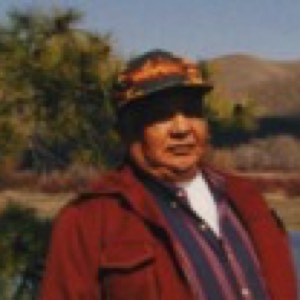
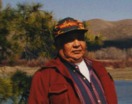 John StanislawⱢu ƛ̓e es t̓x͏ʷt̓x͏ʷmulex͏ʷ ɫiʔe…
John StanislawⱢu ƛ̓e es t̓x͏ʷt̓x͏ʷmulex͏ʷ ɫiʔe…
K͏ʷem̓t šey̓ ɫu tsq̓si k͏ʷm
ta epɫ ɫp̓ɫp̓ulex͏ʷtn ɫu tsq̓si.
L še u ec̓x̣ey es mlk͏̓͏ʷmúlex͏ʷ u ta epɫ
ɫp̓ɫp̓úlex͏ʷtn…
________________________
Č̓e čmi u epɫ q̓͏ʷɫox̣͏ʷmi ɫu stmtem̓ ɫu
tɫp̓ɫp̓úlex͏ʷtn yetɫx̣͏ʷa…
_______________________
K͏ʷem̓t ye x̣͏ʷa x͏ʷuʔuy
yecč̓ʔe ɫu ck̓͏ʷɫči
ɫu suyapi…
_______________________
U k͏ʷem̓t ye cx͏ʷu-u-uy yečč̓ʔe x̣͏ʷa ɫu
ck̓͏ʷɫči suyapi u k͏ʷem̓t cuntm,
"L še mk͏ʷlciʔ," u we tam
sqlix͏ʷuʔulex͏ʷ še
l še u qmintm.At this time the land has changed…
So long ago, of course, there were
not any land measurements done. All
over the land, there were not any lands
measured…
________________________
Now, there are fences around lands
that have been measured out…
________________________
Something happened to the Indian
lands when the white people arrived
here…
________________________
Then in later years, when the white
people arrived, the people were told,
“This is where you will live,” even
though it was not their aboriginal land
where they were put. - Page 151 — John Stanislaw [+]showshow
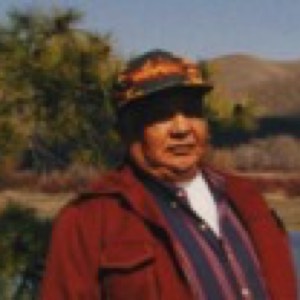
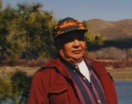 John StanislawIše x̣e ɫu n̓e es q̓ey̓q̓ey̓.
John StanislawIše x̣e ɫu n̓e es q̓ey̓q̓ey̓.
X̣͏ʷa n̓em eɫ t qe sx͏ʷsix͏ʷlt, qe
snk͏ʷsqélix͏ʷ…
________________________
Tl še m es mimisteʔes, yosteʔes ɫu x̣͏ʷl̓
qe nq͏ʷlq͏ʷeltn qe nuwewlštn.… Es
čmiyepleʔ t šey̓ še n̓em el yoyoot ɫu
qe sqlix͏ʷscut.
________________________
X̣͏ʷa n̓em x̣͏ʷa c̓x̣ey taqs nɫeptmntm
ɫu qe nq͏ʷlq͏ʷeltn
ɫu qe cuut ec̓x̣ey.
________________________
Ɫu tl čis cp̓ox̣͏ʷtil̓ši u q͏ʷu cuntm, "Ta
qes nɫeptmntx͏ʷ ɫu an nuwewlštn," ɫu
t p̓ip̓x̣͏ʷot u q͏ʷu cmeyeɫtm.
________________________
Q͏ʷu es cunm, "Ta qes nɫeptmstx͏ʷ, ta
qes x̣͏ʷelsstx͏ʷ ɫu an nq͏ʷlq͏ʷeltn u ɫu an
nk̓͏ʷul̓mn."It is good when things are written down.
Maybe it will be our children, our
people…
________________________
From this they will know and learn
about our language… It is known
that that our culture will become known
again.
________________________
In that way it is possible that our
language and culture will not be
forgotten.
________________________
When I was growing up, I was told by
my elders, “Do not forget your
language.”
________________________
I was told “Do not forget, do not let go
of your language, or your culture.” - Page 154 — Tony Incashola[+]showshow
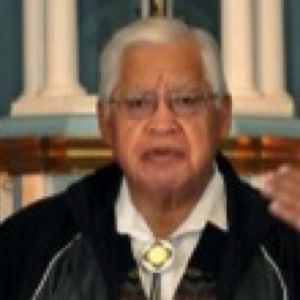
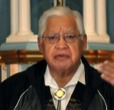 Tony Incashola
Tony Incashola
photo courtesy MissoulianⱢu x̣͏ʷl̓ in x̣͏ʷlč̓musšn,
x̣͏ʷl̓ šey̓ učn̓es q͏ʷeyɫɫmiʔ yetɫx̣͏ʷa.
X̣͏ʷl̓ šey̓ u qe es k̓͏ʷul̓m ɫu qe sck̓͏ʷul̓
yetɫx̣͏ʷa, tam x̣ʷl̓ q͏ʷoyʔe, tam x̣͏ʷl̓
qʔenple, x̣͏ʷl̓ qe sx͏ʷsix͏ʷlt, x̣͏ʷl̓ qe
x̣͏ʷlč̓musšn ɫu nk̓͏ʷuʔul̓mis.
X̣͏ʷl̓ šey̓ u qe es q̓͏ʷeyɫmiʔ yetɫx̣͏ʷa.
X̣͏ʷl̓ šey̓ u qe es nte: k͏ʷmiʔ eɫ
yoʔnuʔuys ɫu qe sx͏ʷsix͏ʷlt ɫu ʔune
nk̓͏ʷul̓mis ɫu qe x̣͏ʷlč̓musšn. N̓e eɫ
k͏ʷeʔeys ɫu nk̓͏ʷul̓mis n̓em x͏ʷuy m eɫ
yoyotwil̓š esyaʔ ɫu sqélix͏ʷ ye l st̓úlix͏ʷ.
It’s for my ancestors, that is why I’m trying
hard at this present time.
That is why we are doing the work that we
do now. It’s not for me, it’s not for us,
it’s for, for our children,
for our ancestors’ ways.
That is why we are working hard today.
That is what we think: I hope our children
will re-learn the real ways of our ancestors.
If the children will take back those ways,
everyone will go and get strong again on
this land.
Privacy Pollicy
Copyright © 2015
Salish-Pend d’Oreille Culture Committee All Rights reserved
Contact Us
Phone: 406 745 4572
Fax: 406 745 4573
Address: PO Box 550
81 Blind Barnaby
St.Ignatius Mt 59865
About Us
This website has been developed in order to allow public access to our media resources. Explicit use of all media apply as per our copyright agreement. We provide access to all content in order to encourage the development of knowledge for our history our language and our culture.


